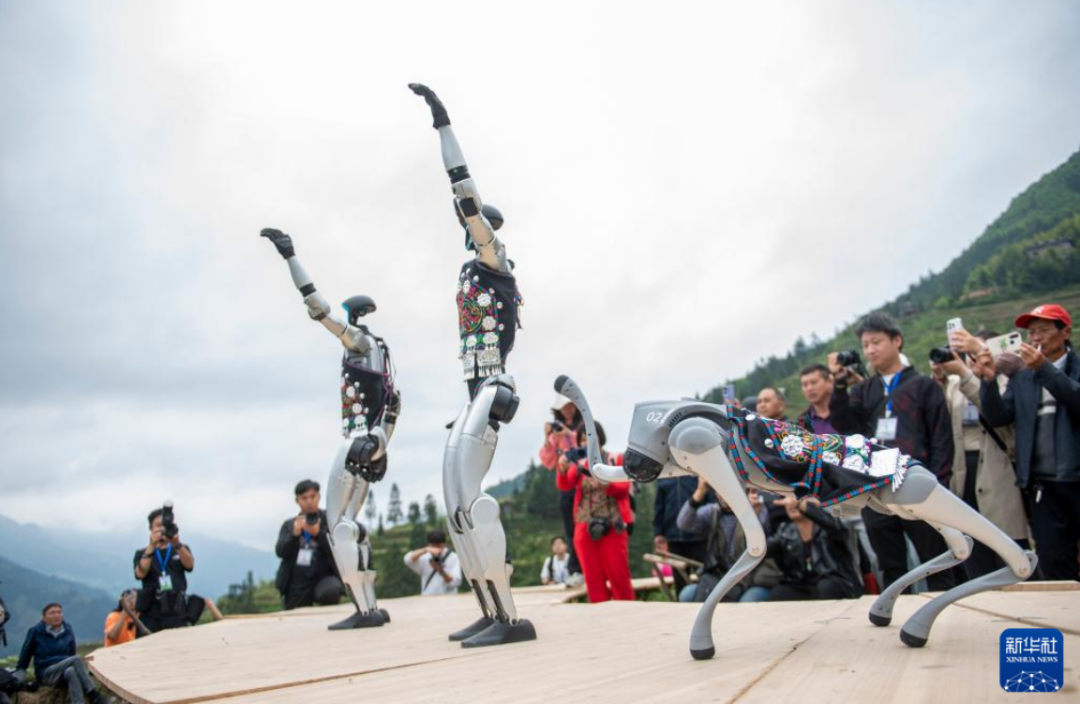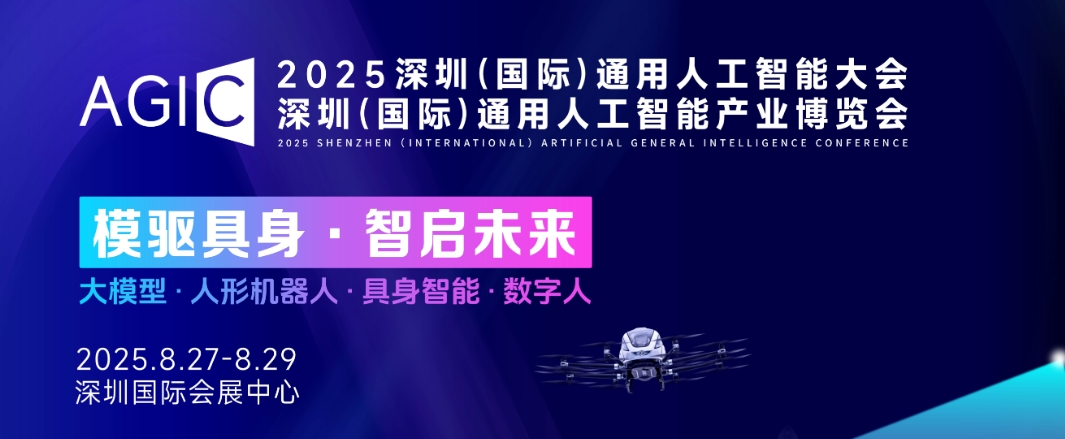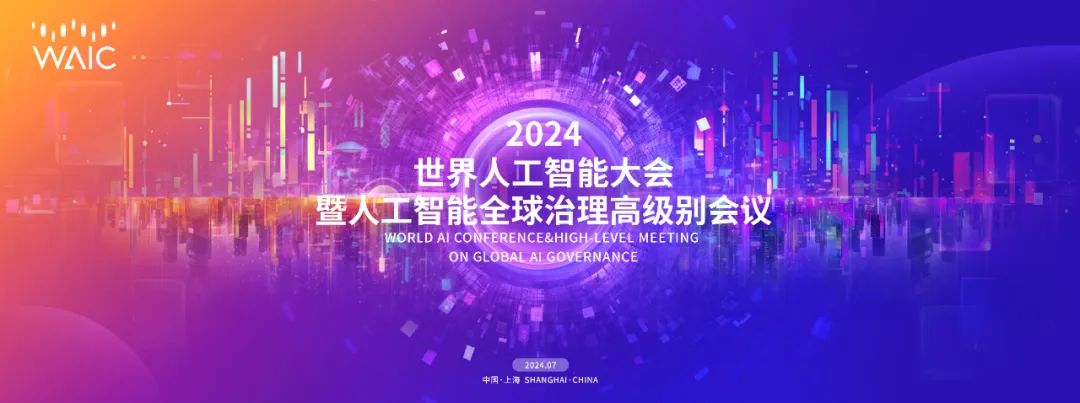
With the rapid advancement of technology, the robot industry is accelerating its transition towards intelligence. Especially since the beginning of this year, a series of deployments have been made from the central to local governments to cultivate embodied intelligence and develop intelligent robots. The resonance between policy and market is creating new opportunities, and the industry is developing vigorously.
Institutions predict that during the 14th Five-Year Plan period, the scale of China’s robot industry will grow to approximately 400 billion yuan. The future is here, and opportunities are limitless.#AI Application Observation #Application Observation #AI Observation On April 26, 2025, robots participated in a terraced rice field fashion show in Jiangjiang County, Guizhou Province.
On April 26, 2025, robots participated in a terraced rice field fashion show in Jiangjiang County, Guizhou Province.
Robots are strutting on the runway, assisting in car manufacturing in factories, and providing help in education, healthcare, and urban management… Today, robots have been widely applied and have entered our lives.
With the rapid advancement of technology, the robot industry is accelerating its transition towards intelligence. Especially since the beginning of this year, a series of deployments have been made from the central to local governments to cultivate embodied intelligence and develop intelligent robots. The resonance between policy and market is creating new opportunities, and the industry is developing vigorously.
Institutions predict that during the 14th Five-Year Plan period, the scale of China’s robot industry will grow to approximately 400 billion yuan. The future is here, and opportunities are limitless.
Fire, the broad prospects for robots to “break out of the circle”
Before the May Day holiday, intelligent robots were “employed” on Bibo Island in the Jinhai Lake Resort in Pinggu, Beijing. They interact with tourists through cruising and guiding, providing a new way to experience cultural tourism.
The person in charge of Bibo Island Resort stated that intelligent robots make tourism more “intelligent and interesting” and help the scenic area achieve refined management, adding “intelligent power” to the cultural tourism industry.
From participating in marathons to working more intelligently in factories, this spring, robots are “breaking out of the circle,” and the entire industry is riding the wave.
New products and applications are being launched intensively——
On March 11, Zhiyuan Robotics released the Lingxi X2, a bipedal intelligent interactive humanoid robot that integrates functions such as movement, interaction, and operation; just a day later, on March 12, UBTECH and the Beijing Humanoid Robot Innovation Center jointly released a full-size research and education humanoid robot, which is planned to be delivered in the second quarter.
At various professional exhibitions, one can more intuitively feel the concentration of innovation. For example, at the recent Robot Industry Link Conference held in Shenzhen, industrial robots achieved an upgrade from “mechanical arms” to “intelligent brains,” and collaborative robots demonstrated intelligent operation solutions, showcasing their “dexterous hands” and “electronic skin,” with participating companies showcasing their unique skills, constantly making headlines.
New products are frequently appearing on the market, and production is surging. Sales of “electronic skin” have increased tenfold, orders for direct-drive motors in January have exceeded half of last year’s total, and the new generation of intelligent elderly care robots is gaining popularity in the market… In Dongguan, Guangdong, many robot companies have secured a large number of orders.
In the first quarter, the production of industrial robots and service robots in China reached 149,000 units and 2.604 million units, respectively, representing year-on-year growth of 26% and 20%.
Continuous industry upgrades and accelerated advancement——
”Almost every week, we are looking for projects to understand the latest trends,” sighed a venture capital institution leader, noting that current innovations in robotics are measured not by years but by days.
Take the recently completed marathon robot “Whirlwind Kid” as an example; its previous generation product will walk in May 2024, run in June, complete double-leg jumps and single-leg jumps in July, and start dancing skills in October… The speed of its “growth” is beyond imagination.
Not only humanoid robots but also industrial robots and service robots are making significant strides forward.
In the painting workshop of the assembly line at China Yituo, the painting operation of tractor chassis is underway: the mechanical arm is agilely turning, and the thickness of the paint film is controlled within millimeters. Technicians told reporters that after integrating intelligent technology and 3D models, the mechanical arm can automatically generate spraying paths and adjust parameters based on the on-site temperature and humidity. “Industrial robots can now sense changes in the production environment and achieve adaptive intelligent processes.”
Mobile operation robots are applied in aerospace, semiconductor, and other manufacturing processes with over a thousand units; explosion-proof industrial robots are achieving large-scale applications in manufacturing processes for rail transit equipment; surgical robots are assisting in complex remote surgeries… Behind each landmark breakthrough is a reflection of the industry’s quality improvement.
The industry is making efforts, and policy measures are supportive.
China has established a national artificial intelligence fund with a scale of 60 billion yuan to accelerate the layout of investment projects; the Ministry of Industry and Information Technology is promoting the “robot +” supply-demand matching and application promotion to enhance the resilience of the industrial chain; central and local governments are jointly building innovation centers for embodied intelligent robots and humanoid robots to promote industrial clustering…
Chongqing has proposed to promote core technology breakthroughs around “storage and computing integrated” chips, and Beijing announced that it will release over 10,000 robot application opportunities within two years. Many regions across the country are actively taking action, deepening the layout from the research and development side to the application end.
The China Center for Information Industry Development released a report predicting that during the 14th Five-Year Plan period, the penetration rate of industrial robots in China will significantly increase, service robots will continue to evolve, and humanoid robots will shift from resource-driven to market-driven.
”On one side, new technologies are accelerating industrial iteration, while on the other side, the transformation of manufacturing and service industries is creating vast space. The domestic robot industry is entering a period of rapid development,” said Song Xiaogang, Secretary-General of the China Machinery Industry Federation.
Steady, the industrial chain’s synergy solidifies the foundation
Behind the booming robot industry is the accumulation of the entire industrial chain.
Research shows that from materials, components to electronic systems and assembly integration, the domestic robot manufacturing system is becoming increasingly complete, effectively supporting the industry’s pursuit of innovation and change.
Entering the production workshop of Suzhou Lide Harmonic Drive Technology Co., Ltd., one can see mechanical arms taking out raw materials from the operation box, processing, testing, cleaning, and lubricating to produce flexible wheels in harmonic reducers.
Harmonic reducers are known as the “joints” of robots, requiring high technical and process standards, and have long been monopolized by foreign countries. This “small giant” company continues to tackle technical challenges such as material selection and flexible bearings, controlling transmission errors within 10 arc seconds. Zhang Yuwen, the general manager of Lide Harmonic, stated that the company is aiming at the new trend of embodied intelligence, developing integrated robotic joints to support the construction of more complex robotic systems.
From domestic breakthroughs to domestic replacements, today, domestic harmonic reducers have captured over 40% of the domestic market share.
Not only reducers. In recent years, China has continuously increased its efforts to strengthen the entire robot industry chain: identifying weak links, making systematic deployments around strengthening core technology breakthroughs; launching “challenge lists” for cutting-edge fields and key links; from technology enterprise incubators to support policies for the first set, first batch, and first version, bridging the gap between industry, academia, and research, and gathering industrial synergy to tackle industry shortcomings.
Breakthroughs at various points have effectively enhanced the resilience of the chain, and with the acceleration of the localization process in key areas, China’s “Iron Man” has gained a more solid support.
Observing the industry, multi-point innovation blooms along the chain——
Zhejiang Lingqiao Intelligent Technology Co., Ltd.’s five-finger mass-produced dexterous hand achieves precise measurement and fine perception of the environment and operating objects; Reiser’s high-performance servo motors enhance the motion control capabilities of robots; CATL’s high energy density batteries provide stronger power for robots… From mechanical arms, sensors to batteries and body manufacturing, almost every part of the robot has domestic suppliers playing important roles.
Observing the market, application expansion accelerates iteration——
”We are growing together with domestic brands.” During interviews, many company leaders expressed this view.
China’s manufacturing industry has a robot density of 470 units per 10,000 workers, and the vast manufacturing scale provides rich scenarios for industrial applications. Especially in recent years, industries represented by the “new three samples” have grown stronger, enhancing the discourse power of the industrial chain and driving a batch of domestic robots to “go to work,” with market experience accelerating the growth of domestic suppliers.
This is a scene from the “Robot Valley” in Nanshan, Shenzhen: the tactile sensors from PAXINI can be directly supplied to UBTECH just a street away, and the simulation data from Kuawei Intelligent can be input in real-time into the training system of Zhiyuan. From laser radar, mechanical arms to dexterous hands, the supply chain is right at home, with the collaborative effect of “developing in the morning, testing in the afternoon, and iterating in the evening” beginning to show.
”China has formed a complete industrial chain layout covering all upstream and downstream fields of robots, with further improvements in autonomy, product competitiveness, and penetration rates in key industries,” said Song Hongjun, a senior researcher at the National Investment Corporation’s Advanced Manufacturing Industry Research Institute. Although there are still bottlenecks in motion control algorithms and high-precision sensors, and some links remain unresolved, the synergy between policies and markets is driving the industrial chain to deepen its layout. “The robot industry is undergoing a qualitative change from ‘component assembly’ to ‘intelligent symbiosis.'”
Intelligence, grasping direction and striving for progress
Robots are an emerging industry and a key industry supporting digital upgrades. In the face of technological competition, it is crucial to take the initiative and seize opportunities.
Entering the humanoid robot data training center located in Beijing Shougang Park, engineers wearing wearable devices control robots to accurately complete tasks such as watering, flower arranging, and folding clothes through remote operation.
Zhang Qinfeng, the center’s director, told reporters that high-quality data sets are the gateway for robots to understand the world. A current important task is to accelerate the “density” of practical training, quickly accumulate data, and promote evolutionary upgrades.
Empowering with “data” to create a “smart brain” for robots——
Since the beginning of this year, many regions have announced the strengthening of the construction of embodied intelligence training centers, targeting the problem of data scarcity, with various “robot vocational schools” and “data factories” accelerating their establishment. At the same time, the industry is also exploring new technologies and expanding new ways to obtain data.
Beijing Galaxy General Robot Co., Ltd. is attempting to use synthetic data-driven technology to train robots with data produced by physical simulators. The company’s founder, Wang He, stated that they have currently accumulated tens of millions of scene data and billions of action data.
Jingtai Technology’s CEO, Ma Jian, said that the intelligent autonomous experimental platform developed by the company can increase data collection capabilities by 40 times, and over 300 robot experimental workstations have been deployed, accumulating a large amount of standardized, high-quality experimental data.
In addition, the digital “foundation” is also being further solidified. The National Data Bureau has clarified that it will systematically promote the construction of a national integrated computing power network and promote interconnectivity of regional and industry data infrastructure. The Ministry of Industry and Information Technology has proposed to strengthen the research and deployment of general large models and industry large models, accelerating the construction of high-quality data sets in the industrial field.
”Wherever the ‘artificial intelligence +’ action goes, the construction and promotion of high-quality data sets must follow,” said a relevant person from the National Data Bureau, who will fully mobilize all sectors of society to continuously increase data supply.
Aiming for the future, strengthening basic research and forward-looking layout——
In the “Mosu Space” large model innovation ecological community in Shanghai, Wenshen Chip has achieved collaborative operation of various large model algorithms on multiple chips through self-developed technology; Xiyu Technology is continuously breaking through multi-modal large model technology, accelerating the development of AI intelligent agents… Here, the model of “upstairs and downstairs is upstream and downstream” promotes cooperation among resident enterprises from basic technology, application research and development, and scene design, accelerating the emergence of a batch of cutting-edge technologies.
In Yizhuang, Beijing, the national and local governments jointly built the embodied intelligent robot innovation center released the general embodied intelligent platform “Wisdom Open Material,” achieving compatibility of a single software system on various configurations such as mechanical arms and wheeled robots. The technical achievements are open-sourced to the industry, drawing on the strengths of many, and accelerating the joint tackling of key common technologies.
Moving towards high-quality development, the robot industry still faces many challenges to be solved. For example, there are shortcomings in basic theoretical research and basic technology breakthroughs; the high hardware costs of humanoid robots restrict large-scale applications.
From AI model foundations to high-performance computing chips, from brain-like intelligence to the next generation of communication, the industry and academia are increasing interdisciplinary and cross-field integrated innovation, actively integrating industrial resources, and collaboratively exploring solutions.
At the beginning of the year, China took the lead in formulating the world’s first international standard for elderly care robots; not long ago, the first batch of national standards for humanoid robot technical requirements was approved for project establishment… Establishing standards and norms continuously promotes the steady advancement of the industry.
”In this long-distance race to cultivate new productive forces, we must strengthen technological supply and also put significant effort into strategic planning and talent cultivation, especially optimizing industrial layout and strengthening normative construction,” said Xiong Youjun, general manager of the national and local joint innovation center for embodied intelligent robots, emphasizing that taking steadier and firmer steps will ensure that every “small step” forward for robots becomes a “big step” in promoting industrial development, achieving a leap from “finishing a half marathon” to “running towards the future.”





